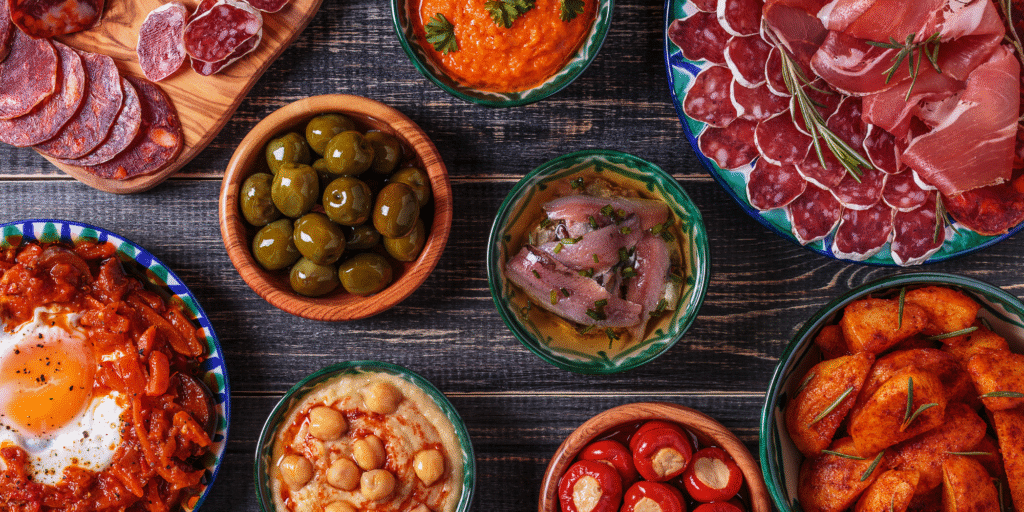Tapas are one of Spain’s most iconic culinary traditions. For newcomers, it may seem like just “snacking,” but tapas represent a way of life—a flavorful, social, and deeply rooted experience.
In this beginner-friendly guide, you’ll learn what tapas really are, when to enjoy them, and how to navigate a tapa bar like a true local.
What Are Tapas?
Tapas are small plates of food served with drinks, often designed to be shared. Their name comes from the word “tapar”, meaning to cover. Originally, they were placed over drinks to prevent dust or flies—but they’ve grown into something much bigger.
For instance, ordering a caña (small beer) might come with a small tapa in some regions.
In fact, in cities like Granada, you still receive free tapas with your drink—no strings attached.
Common Types of Tapas
Here are a few staples you’ll likely see on any tapas menu:
- Tortilla Española – A potato and egg omelette
- Patatas Bravas – Fried potatoes with spicy tomato sauce
- Albóndigas – Spanish meatballs in sauce
- Gambas al Ajillo – Garlic shrimp sizzling in olive oil
- Croquetas – Fried béchamel and ham fritters
- Pimientos de Padrón – Small green peppers (some spicy!)
On the other hand, many places offer regional specialties based on local ingredients.
📍 Related read: Explore 10 Classic Spanish Dishes You Must Try
When and How to Eat Tapas
Unlike meals in North America, tapas are typically not eaten all at once. Instead, Spaniards enjoy them around 7 to 9 PM, often before dinner.
Many locals go on a tapeo—a tapas bar crawl. They order a drink and one or two small plates at each stop, enjoying conversation along the way.
Meanwhile, lunch menus often include tapas as starters.

Different Tapas in Spain
Drinks to Pair with Tapas
Tapas are almost always paired with drinks. Here are some common choices:
- Cerveza (beer) – Often a small glass called a caña
- Tinto de verano – Red wine with soda water
- Vermut – Sweet vermouth, popular in Madrid
- Sidra – Cider, especially in northern Spain

Friends enjoying tapas and wine at outside
For example, in coastal towns, it’s common to enjoy grilled seafood tapas with crisp white wine.
Tips for Tapas Etiquette
To blend in with locals, follow these simple tips:
- Order slowly and don’t rush—tapas are a relaxed experience
- Don’t expect a detailed menu—ask for recommendations
- Stand at the bar—it’s more social and sometimes cheaper
- Share everything—tapas are meant to be communal
Although casual, tapas culture has its own rhythm and etiquette.
Where to Enjoy Tapas in Spain
Tapas are everywhere, but some cities are especially known for their offerings:
- Granada – Famous for free tapas with drinks
- Seville – Full of classic Andalusian tapas bars
- Madrid – Great mix of traditional and modern tapas
- San Sebastián – Known for pintxos, the Basque take on tapas
- Logroño – Amazing tapas and wine culture in La Rioja
🌐 For local food guides and events, check Spain’s Official Tourism Site.
Tapas Visuals and Image Suggestions
Add beautiful, high-resolution photos to increase engagement and SEO:
- Image: “A plate of patatas bravas with spicy sauce” – alt: Traditional patatas bravas with red sauce
- Image: “Friends enjoying tapas and wine at a bar” – alt: People sharing tapas in a Spanish bar
- Image: “Tortilla Española with a slice cut” – alt: Spanish potato and egg tortilla sliced open
Bonus Tips for First-Time Tapas Travelers
✅ Visit a busy bar—locals know where the best food is.
✅ Try at least one unfamiliar tapa—you might find a new favorite.
✅ Ask for the specialty of the house—every place has one.
Final Thoughts: Tapas Are a Way of Life
Tapas aren’t just about food—they’re about connection. They encourage conversation, sharing, and exploration of Spain’s diverse flavors.
📌 Save this post for your upcoming trip. Try a tapeo, ask for the house specialty, and enjoy each tapa as a new adventure.
🍷 Want to learn how to order with confidence? Check out our Essential Food Phrases in Spanish for travelers.
